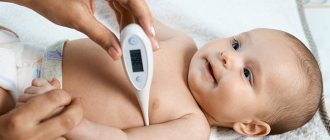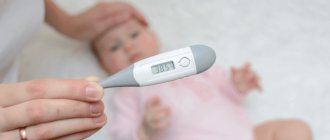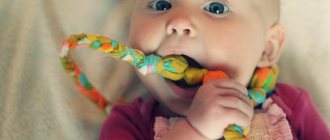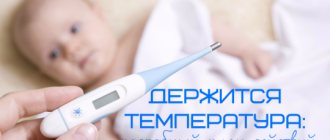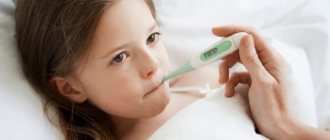When a child is sick, loving parents cannot find a place for themselves. After all, even knowing that high temperature is most often a completely normal reaction of the human body to injury or some kind of disease, we all strive to alleviate the condition of our loved one.
Everyone understands that the main fight against a febrile state lies in treating the disease that caused it. A high temperature is an indicator that the body has begun to fight harmful viruses. This means that the use of antipyretics is not justified in all cases. However, fever is always scary, so we decided to devote our article to the question of what to do if a child has a high temperature and it does not go down.
A terrible phenomenon - fever
Normal body temperature is the key to the proper functioning of the entire body. Its stability is extremely important for internal organs. Correction of indicators is carried out due to the skin, the temperature of which is constantly changing. Homeostasis (balance) exists due to thermoregulation, which consists of two important processes:
- heat production - energy is generated during metabolism and muscle work;
- heat transfer - excess heat is eliminated through the evaporation of moisture through the skin and during breathing.
A constant balance between these phenomena is maintained by the hypothalamic thermoregulation center, which is located in the brain. Responding to the appearance of endogenous pyrogens in the blood, which, in turn, are produced during inflammatory processes or collisions with foreign proteins, the hypothalamus slows down heat transfer. As a result, body temperature rises.
Its increase is recognized as a natural and even necessary reaction of the body in response to the invasion of foreign agents. With increased levels, immune cells are mobilized, metabolism accelerates, antibodies are produced, other protective mechanisms are triggered, and most microbes simply die.
There are 3 stages of fever development:
- Increasing performance. The process of heat production predominates. The child may feel chills, body tremors and aches may occur.
- Increased body temperature. The level of heat production and heat transfer correspond to each other. The thermometer reading is 38.5℃ or higher. The baby appears flushed and the skin is hot.
- Decrease in temperature. Heat transfer predominates. Breathing quickens, sweating begins, the skin becomes cool, and indicators drop rapidly.
If the fever does not go away, then the body is stuck at stage 2, it is important to start the process of heat transfer. Parents do not always do this correctly; in severe cases, it is not possible to achieve progress on their own.
For more information about what to do if a child has a temperature of 40, read the article at the link here.
Signs and causes of temperature
As the temperature rises, the human body reduces sweat production, while increasing muscle tone and metabolic activity. There is a rapid heartbeat, lack of appetite, dry and hot skin, a feeling of chills, weakness and muscle pain. To relieve these symptoms, antipyretics are given. But what to do if they don’t work and if the child’s temperature does not go down to 39? This happens for the following reasons:
- The presence of an acute viral disease aggravated by a bacterial infection (otitis media, pneumonia, meningitis, etc.).
- Inflammation of the lining of the brain, in which fever is accompanied by delirium, confusion or loss of consciousness, vomiting and headache.
- Complex endocrine disorders.
- Inflammatory purulent processes (abcesses, phlegm in the acute stage).
- Entry into the body of specific viruses: Epstein-Barr, rotavirus.
Causes of hyperthermia
A high temperature in a child, which is not reduced by antipyretics, is observed in the following cases:
- severe bacterial infections, which include pneumonia, obstructive bronchitis, otitis media, meningitis;
- purulent diseases - phlegmon or abscess;
- viral mononucleosis;
- infectious diseases occurring against the background of hormonal disorders;
- chickenpox and measles;
- genitourinary system infections;
- angina.
In this case, the child’s high temperature does not go down for long or does not go down at all. To normalize the baby’s condition, parents wipe him with a damp towel, uncover him, and be sure to offer him plenty of drink.
Parents' actions
An increase in body temperature is an important stage in the functioning of the immune system. It has been proven that children who get sick with a high temperature have stronger immunity compared to those children who get sick with the same frequency without a fever. Therefore, pediatricians recommend that parents do not rush to give antipyretics (antipyretics). Read more about the normal temperature for infants here.
If the baby is less than 3 months old and the thermometer shows 38 ℃, it’s time to resort to medication and call a doctor. At the upper norm threshold of 37.5 ℃, such values are considered elevated. Due to the immaturity of regulatory mechanisms, there is a risk of complications, so qualified assistance is necessary.
38 ℃ is a reason for urgent measures if the child is one year old or older, but has a history of:
- somatic pathologies;
- cardiovascular diseases;
- congenital diseases;
- endocrine disorders;
- neurological disorders;
- febrile seizures.
Previously healthy children who develop a fever should not lower their temperature below 39 ℃. If the thermometer showed, for example, 39.3 ℃, the medicine was taken, but the readings remain the same, you need to calm down and find out the reasons for this situation.
If a child’s high temperature is not being controlled by anything, parents should know what to do.
| Mark on the thermometer | Symptoms | Adult Actions |
| Up to 38 degrees | The baby is lethargic, sleepy, shivering, and his eyes are shining. | If the baby does not suffer from seizures, then with such indicators it is not worth taking antipyretics. The sick baby is soldered. To do this, offer water or compote. |
| 38 – 38.5 degrees | The patient is sleepy, his face becomes red, there is no appetite. | Pediatricians do not recommend lowering this temperature, but you can refuse medications only if the child tolerates hyperthermia normally. |
| 38.5 – 39 degrees | At this temperature, the baby’s condition is serious, the skin is cold and pale. Cold sweat may occur. | The baby must be given antipyretic drugs. They take off his excess clothes, leaving him in a T-shirt and panties. |
| 39 – 39.5 degrees | With such indicators, blood circulation is impaired. The patient's extremities become cold and convulsions occur. | They give an antipyretic along with No-shpa. This helps eliminate cramps. |
| 39.5 – 40.0 degrees | The baby is weak, capricious, wants to sleep. The eyes shine, the cheeks turn red, capillaries appear on them. | Give Nurofen or use Analdim suppositories. The patient's hands and feet are wiped with a towel dipped in cold water. |
| Over 40 degrees | A critical condition that requires urgent medical attention. Convulsions often occur, and consciousness may be impaired. | The patient is given an intramuscular injection of Diphenhydramine with Analgin. |
What to do if your child has a temperature of 39.5
The main thing is not to panic, because your excitement will probably pass on to the baby, who is already having a hard time. Pull yourself together and start taking action. First, let's figure out what temperature indicators are considered critical.
| 38-38,5 | 38,6-39,5 | Above 39.5 | Above 40.5 |
| Mild fever | Moderate heat | High heat | The threshold beyond which the temperature can be life-threatening |
The table shows that 39.5 is a fever that requires urgent use of medications that lower body temperature! To exclude complications, be sure to show your child to the doctor.
The danger of white fever
A child’s high temperature not only goes down poorly, but also increases with the so-called “white fever”. At the same time, the baby suffers from chills and has cold extremities.
If you have symptoms of “white fever,” you should not hesitate; normalizing the temperature on your own is problematic, so you should urgently call an ambulance. In a hospital setting, the doctor will make a diagnosis and then prescribe the necessary treatment.
Some adults are confident that they can easily cope with elevated temperatures, but this is absolutely not the case. If the mark on the thermometer is over 39 degrees and the patient’s condition cannot be normalized, it is necessary to call a doctor. Prolonged hyperthermia leads to irreversible processes in the body. No matter how parents feel about drug treatment and hospitalization, with “white fever” you cannot do without the help of a doctor.
It must be remembered that hyperthermia is only a symptom of a disease. To stabilize temperature indicators, it is necessary to eliminate the root cause of this phenomenon.
What to do if your child has a high fever, vomiting and diarrhea
If the fever is accompanied by intestinal disorders, you should definitely not self-medicate! Urgently call a pediatrician or an ambulance, because, most likely, the child has contracted an acute intestinal infection that requires specialized treatment!
It is also important to consult a doctor if you notice a sharp deterioration in the baby’s condition, even while taking antipyretic drugs. Don’t be negligent about your baby’s health, be attentive to all manifestations of the disease and you will definitely cope with it!
Memo to parents
- A child’s fever may persist if the medicine is used incorrectly, the rules for providing assistance with fever are violated, or the child has serious health problems.
- Antipyretic drugs (based on ibuprofen or paracetamol) are given to previously healthy children at 39 ℃.
- The effect appears within 40-60 minutes.
- If there is no result, you can use another drug without waiting 4 hours.
- If the high temperature persists after using an alternative medication, you should call an ambulance.
- If the fever lasts longer than 24 hours, you need to go to the clinic.
How to reduce a fever
To reduce the temperature, you will need to use antipyretic drugs. The local question about what to do if the baby’s temperature does not subside is determined by the use of antipyretics. Doctors, in order to lower the temperature, recommend using drugs for children such as Ibuprofen or Paracetamol.
After taking these drugs, there is a decrease in fever after some time. The duration of action of antipyretics is four hours, after which the thermometer may rise again.
It is important to know! Children need to be given antipyretics in a certain dosage, which you should read in the instructions for the drug. If the dosage is exceeded, it will lead to the development of side symptoms.
If on the third day of taking antipyretics the fever continues to rise, then you need to go to the hospital for examination. Before taking an antipyretic in the form of syrup, you should make sure that the baby has no signs of nausea and vomiting. Rectal suppositories are used for children if there are no symptoms of diarrhea or diarrhea. In conclusion, it should be noted that in order for body temperature to decrease, a number of additional requirements must be met:
- provide comfortable indoor conditions;
- undress the baby and cover him with a light cloth;
- ventilate the room;
- apply lotions if necessary.
If the temperature continues to rise, which indicates the severity of the disease, it is necessary to call an ambulance or use a “lytic mixture”.
Physiology
Fever is one of the most important protective and adaptive reactions of the body. In the process of increasing body temperature, all vital systems of the body (immune, respiratory, cardiovascular) are activated. In fact, this process is regulated by the body.
Academician Pavlov wrote the following about this process: “There is a center - these are the internal organs and a shell - this is the skin and mucous membranes. The temperature of the center is always constant, the temperature of the shell is always changing. The constancy of the temperature of the internal organs is maintained due to the variability of the skin temperature; it is through it that the “extra” degrees are released. And this difference depends on heat production and heat transfer.”
Fever is a change in heat balance caused by the effect of endogenous pyrogens on the hypothalamic thermoregulation centers.
A moderate increase in body temperature can be observed during the daytime in many healthy children; most often this increase is subfebrile in nature - 37.3 - 37.5 ˚C.
The range of daily fluctuations in body temperature at a relatively constant ambient temperature in the first days of life is about 0.2 - 0.3 ˚С, by 2 - 3 months it increases to 0.6 ˚С, and by 3 - 5 years it reaches 1 ˚С . The highest body temperature is observed between 17 and 19 hours, and the lowest in the interval between 4 and 7 hours. Fluctuations in body temperature reflect the state of physical and psycho-emotional activity of healthy children.
First aid measures
Only a doctor can determine why a child’s fever is difficult to control. Before the doctor makes a diagnosis and prescribes treatment, parents should try to normalize the temperature.
- A sick baby is reassured and often offered a warm drink. Give water in small portions, otherwise vomiting may occur.
- If the baby's limbs are cold, rub them with your hands until they warm up.
- Antipyretics are given in therapeutic dosages. If you have experience in giving injections, then a solution of Analgin, Papaverine, Diphenhydramine is injected intramuscularly.
- If a 3-4 year old child has a high fever that is difficult to control, give a mixture prepared from Analgin, paracetamol, and No-shpa. For children of this age, take 0.2 mg of Analgin and paracetamol, plus half a No-shpa tablet. Antihistamines help lower the mark on the thermometer; Zodak or Claritin are given along with antipyretic drugs.
If the child’s high temperature (39 and above) does not go down, then the emergency doctors give an injection, after which the patient falls soundly asleep. Temperature readings quickly return to normal after intramuscular injection. Doctors inject Analgin with Diphenhydramine and Papaverine, but sometimes resort to Dexamethasone injections.
Stages of fever
- stage one - temperature rise. Most often, parents notice that the child is shivering, the baby complains of feeling cold, especially when moving. At this stage, usually the processes of heat production prevail over the processes of heat transfer, breathing slows down, and sweating decreases;
- Stage two is the stage of increased temperature. The very stage at which parents usually sound the alarm. Heat transfer and heat production are usually approximately equal at this moment. The skin is red and hot to the touch;
- stage of temperature reduction. At this stage, heat transfer predominates, the child’s skin is red, active sweating occurs, and breathing is quite frequent.
Perhaps it is precisely because of this stage that the myth persists among the masses that in order to get better, you need to sweat. And it is this myth that forces thousands of parents to wrap up an already feverish child, close the windows and thereby only worsen the baby’s condition, leading to
hyperthermia
- overheating.
Hyperthermia is a process that (unlike fever) is not regulated by the body. May lead to disruption of body systems.
The most common causes of hyperthermia:
- pituitary tumors;
- brain injuries;
- CNS infections;
- shock, sepsis;
- hyperthyroidism.
Hyperthermia occurs in young children and is characterized by a violation of the heat transfer mechanism. The child is pale and cold.
Therefore, if the child is red and hot to the touch, and the temperature has risen to 39˚C, this process will proceed favorably in most cases.
Reason #2 - “Bad” parents
When the temperature is difficult to control, give antipyretic syrup in a therapeutic dosage or use a rectal suppository with Paracetamol. For the treatment of young children, it is allowed to use drugs based on Paracetamol and Ibuprofen. Children cannot be treated with drugs containing Aspirin, since this drug has many side effects.
In your home medicine cabinet you should keep the drug with Ibuprofen and Paracetamol at the same time. If one medicine does not work well, then a second is taken a couple of hours later. Doctors recommend drinking each syrup no more than 3 times a day.
If syrups do not help, they resort to rectal suppositories called Analdim. This drug contains analgin and Diphenhydramine. When buying such suppositories, take into account the age of the sick child, since the dosage of the active substances is different.
Antipyretics take effect after 30-40 minutes. During this time, the baby is wiped with a towel soaked in warm water. Previously, grandmothers added alcohol or vinegar to water, but modern pediatricians do not recommend doing this, believing that these substances penetrate the skin, causing intoxication.
Wiping with water should not be done if the baby’s limbs are cold. In this case, the baby should be given half a No-shpa tablet to relieve vasospasm.
At a temperature of 38-38.5 degrees, the baby becomes lethargic, sleepy, refuses to eat, and a feverish shine appears in the eyes. In the absence of seizures, it is not yet advisable to resort to the use of antipyretics. Give your child plenty to drink.
If the temperature reaches 39 degrees, the skin turns pale and cold sweat begins. The child must be removed from all excess clothing, given an antipyretic and an ambulance called.
First, parents should take a closer look at the medication that was given to their sick child. You need to dwell on the name of the active substance. Children are given drugs based on paracetamol (Panadol, Efferalgan) or ibuprofen (Nurofen, Ibufen). Such recommendations were made by WHO, assessing the effectiveness, safety and other characteristics of these substances. Adults can keep all other funds for themselves.
Next, you need to see if the medicine has expired and how long it can be stored after the first opening. If one of the deadlines has expired, you need to throw away the bottle and run to the pharmacy for a new one (open bottles have a shorter shelf life than sealed ones). In this case, the reason for the lack of effect has been found.
If everything is in order with the name and timing, we evaluate the dose used. The number of milliliters from the plate printed on the cardboard box needs to be double-checked. You should rely on the weight of the small patient:
- Ibuprofen. The daily dose is 10 mg/kg. Divide the resulting amount by 4 (average frequency of administration). It turns out to be a single dose. We evaluate the concentration of the syrup (most often 100 mg/5 ml). We calculate how many ml contains the amount of substance we need.
- Paracetamol. The daily dose is 15 mg/kg. We carry out calculations similarly to the first option, taking into account the concentration indicated on the package (for example, the concentration of Panadol syrup is 120 mg/5 ml).
If, due to stress, “your head can’t think straight,” you need to ask someone to help or call your pediatrician and clarify the dosage.
If instead of a suspension or syrup the child took antipyretic tablets or was given a suppository, the lack of effect is predictable. During fever, another protective mechanism is triggered - spasm of intestinal vessels (the extremities become pale and cold). That is, the active substance from a tablet or suppository is simply not absorbed into the systemic bloodstream.
Even with the use of the best medicines, the temperature is poorly reduced when the process of heat production is stimulated and heat transfer is blocked. The parents themselves may be to blame for this. In addition to infection or illness, energy production is enhanced by:
- active games;
- psycho-emotional stress;
- heavy food;
- hot drinks.
The effect of the medicine is neutralized, that is, it simply does not occur when there are no conditions for heat transfer. Parents need to check:
- Can he sweat? If the baby flatly refuses to drink water, and the parents radically disagree with giving him a drink or compote, then he does not receive the liquid. No liquid - no sweat - no evaporation. Vicious circle.
- Is the child cold? Cold skin at a temperature means a spasm of its blood vessels, then the production of sweat and normal evaporation of heat is impossible.
- Isn't he wrapped up? Synthetic clothing warms well, but does not absorb moisture well and conduct heat, which means it prevents evaporation. The situation is similar with blankets.
- Isn't it hot in the room? If the room in which the patient is located is heated, very warm, with tightly closed windows, you should not be surprised at the ineffectiveness of the drugs. In children, heat is lost mostly when breathing. The higher the temperature in the room and the drier the air, the worse this process is realized.
The reason for the persistence of fever may be the child’s crying when the parents force feed him or put him on “bed rest”.
In these conditions, the temperature may not decrease until specific medications are prescribed. To select them, you need to accurately diagnose. A specialist will do this faster and more correctly. You need to rush to him if:
- the fever is accompanied by considerable pallor of the child or unusual skin color;
- the patient loses consciousness;
- sleeps constantly;
- poorly oriented in space;
- he has vomiting or diarrhea;
- blood was found in the excrement;
- there are breathing or heart rhythm disturbances.
Does your child have a fever?
First, let's understand one simple rule. To reduce fever, domestic doctors most often prescribe
paracetamol and
ibuprofen . These two drugs are approved for use in pediatrics. But since not all children will want to take a pill (and even more so for infants), for young patients these two drugs are available in the form of syrup. The two most common antipyretic syrups are
Efferalgan (contains paracetamol) and
Nurofen (contains ibuprofen) .
But another common drug among adults - aspirin - is not advisable to give to children due to possible side effects.
- It is advisable to keep these two syrups together in the first aid kit. And if the baby’s temperature does not drop, then you should alternate taking them . For example, first they gave Efferalgan, you monitor the baby - the temperature does not go down - an hour later they gave Nurofen.
- At high temperatures, emergency doctors give the child an injection of analgin and diphenhydramine. The effect of such an injection is lightning fast and the temperature drops before our eyes. If you are not a doctor, then you are unlikely to be able to give an injection to your child at home, but you can easily put a candle. There are such Analdim suppositories , they contain analgin and diphenhydramine. If the antipyretic syrup does not help and the child continues to have a fever, carefully insert the Analdim suppository into the rectum. Acceptable doses are 1-3 times a day (at the pharmacy, ask for suppositories with the required content of analgin and diphenhydramine - they differ depending on the age of the child).
- What else to do? It may take dozens of minutes for the antipyretic to take effect. The child has a fever, so he needs to bring down his temperature, a good way is to wipe it with a solution of water, vodka and vinegar (read how to prepare and use it here). Our grandmothers were saved by them, but modern pediatricians, for example, the famous Dr. Komarovsky, do not allow the use of physical methods of reducing temperature: rubbing, enemas, etc. He says that vodka and vinegar are absorbed through the skin and acid and alcohol poisoning is added to the elevated temperature. If you are afraid to use this truly effective method, then you can limit yourself to wiping with warm water - undress the child, heat the water (it should be warm, but not cold!), dip the cloth in water, wring it out and wipe the child. But do not use rubbing if the child’s feet and hands are cold - in this case, you need to give him No-shpa to dilate the blood vessels.
Temperature in a newborn baby
It often happens that a mother, who has just returned from the maternity hospital, measures the baby’s temperature, sees the number 37.5˚C on the thermometer, gives the child paracetamol, measures the temperature again and realizes that there is no effect.
If the baby willingly takes the breast, does not worry, the umbilical wound is not red, everything is fine with the baby.
Newborn children adapt to life in this imperfect world; their organ systems also adapt, including thermoregulation processes.
Before giving your child medicine, undress him completely, remove the diaper, put a diaper on him, if you are worried about the furniture, check the temperature in the room where the baby is. It should be 18 - 22˚С. Ventilate the room and measure the temperature again. If the actions have an effect, most likely you are overheating the child.
If you are also concerned about nasal congestion, change in stool color, severe anxiety in the child, redness of the umbilical wound or discharge from it, it is better to consult a doctor.
And of course, you need to call a doctor if the newborn’s temperature is 38˚C or higher.
There is another group of children whose parents should be more wary than usual. These are children with somatic pathologies. Such as congenital heart defects, cardiac arrhythmias, epilepsy, central nervous system diseases, thyroid diseases, children who have previously had
febrile seizures
. These children have to bring down the temperature, which has not reached 38.5˚C. The tactics for reducing the temperature of these children are the same as for everyone else, only with lower numbers. And it is advisable to reduce the temperature of these children sharply.
This question comes up quite often, and very often parents make the same mistakes.
1) The first mistake is a diaper, or rather its presence. Nowadays, this thing has become an integral part of raising children, and many people can’t even imagine how to remove it from a child, and even for the whole day. The disadvantage of this thing is that when you put it on the baby’s bottom, you also put it on the groin area, which is rich in large blood vessels. Instead of giving off excess heat, the baby, thanks to this “compress,” adds an extra degree to himself.
Try to replace the diaper with panties with gauze or old towels during the child's illness. Sometimes you can find fishnet panties on sale. It is important that the groin area is as open and dry as possible. Unfortunately, such a replacement will have to be changed every time the child relieves himself.
2) Mothers often complain that they cannot bring down their child’s temperature, and the room where the sick child is is stuffy and hot.
In the room where the baby is, the air temperature should be low 18 - 22˚C, and the humidity should be at least 70%.
The room must be ventilated regularly. Firstly, it will reduce the number of pathogenic microorganisms in the room. Secondly, it will be easier for the child to breathe. Thirdly, it will help you reduce your child's temperature.
3) Clothes. Attempts to wrap him up more, give him hot tea with raspberry jam and do everything to make the child sweat and thus recover can worsen the condition. Clothes should be made from natural fabrics. If the child is chilly, cover and warm him.
But if you see that the child is hot and open, give him a sheet or a very light blanket.
4) Food. Not feeding a child or feeding for two are two extremes. If the child already knows how to speak, ask his opinion. Perhaps he wants some fruit or a particularly tasty dish prepared by his mother. If the baby refuses, do not force him to eat, just put washed fruits and vegetables in a visible place.
In your diet, try to stick to more carbohydrate foods (vegetables, fruits, cereals); if your child doesn’t mind eating yogurt or kefir, don’t deny him this either.
5) Incorrect calculation of the dosage of antipyretics.
Dr. Komarovsky says: “Sit down with dad while your baby is healthy and calculate how much medicine is needed for your baby’s weight.”
The fact is that the calculation of the medicine on the packaging is made for the average child. Thus, if your baby weighs more than average, then you need more medicine than indicated on the back of the package.
6) Rubdowns and cold compresses for white fever. This error is rare.
7) Rubbing with vodka, vinegar or water below the child’s body temperature.
Vodka and vinegar increase intoxication of the body and can lead to allergies or poisoning. Ice water can provoke spasm of peripheral vessels and lead to a decrease in the area of heat transfer.
Lack of drinking. If a child refuses to drink, but the parents cannot, or do not have enough desire to give him something to drink.
Loss of fluid and salts through sweat and exhaled air can lead to a serious condition of the child and subsequently to the threshold of the intensive care unit.
What not to do at high temperatures
Often, young mothers, trying to help their child alleviate the condition, only make things worse with their unconscious actions. You should definitely know what not to do when your child has a high fever.
Do not insulate your child!
It is a mistake to try to wrap your baby as warmly as possible, even if he is suffering from severe chills. Remove everything from the baby that interferes with normal heat exchange, dress him in light cotton clothes and cover him with a cozy blanket. This will make it much easier for the child.
You can’t make compresses, steam your feet, or put mustard plasters on!
This will increase your already high body temperature. These treatment methods are acceptable only at the initial stage of the disease, when there is no fever yet.
You should not give your child hot drinks!
In high heat, it is very important to ensure proper drinking regimen. Insistently give your baby tea, compote, clean water or juice at room temperature. You need to drink a lot, even if you don’t want to! But keep in mind that it is important to avoid brightly colored drinks that can cause allergic reactions.
Helpful Tips:
- It is very important to regularly ventilate the room in which the child is sick. At least 2 times a day, take the baby into the next room and completely ventilate the room! The ideal air temperature in the room for a sick fidget is 20-22 degrees.
- Turn on the humidifier. If there is none, put a bowl of water.
- Don't force feed your baby. When the appetite appears, it will definitely make up for lost time.
- You cannot feed your baby 24 hours a day with antipyretics of the same group. It is recommended to alternate Paracetamol with Ibuprofen, maintaining the time interval specified in the instructions between them.
During the treatment period, exclude the child from being outside.
To grind or not?
Opinion on this issue is divided. Many parents rub the baby's skin with vinegar or vodka solution, trying to cause a decrease in temperature. Whereas the famous pediatrician Komarovsky categorically prohibits doing this, citing the additional burden on the body poisoned by the virus.
When is hospitalization necessary?
To answer the question why a child does not have a high fever, it is necessary to take blood and urine tests. Based on the results, it will be clear what caused the hyperthermia.
In certain cases, with hyperthermia, the baby is hospitalized and further assistance is provided in a hospital setting. When is hospitalization necessary?
- If the child is less than a year old;
- If hyperthermia was accompanied by “white fever”;
- If confusion or seizures have occurred;
- In severely disturbed general condition - nausea, vomiting, dizziness and other symptoms of intoxication;
- If the child has a history of severe chronic illness.
Elevated temperature helps fight infection, but if the readings are too high, then this condition is dangerous for children. In some diseases, it is difficult to normalize the temperature. In this case, the patient is given antipyretic syrups and the baby is wiped with a damp towel. If nothing helps, and the patient’s condition remains serious, you should immediately call an ambulance.
Reasons for urgent temperature reduction
Despite the fact that it is recommended to give the child’s body a chance to fight the infection on its own, there are times when any increase in temperature can become critical:
- increased seizure activity;
- congenital neurological pathologies;
- chronic diseases of the respiratory system, kidneys or cardiovascular system.
You shouldn’t “wait for sea weather” even in cases where the child is clearly getting worse. In this case, you may observe the following symptoms:
- the occurrence of seizures;
- diarrhea or vomiting;
- feverish delirium;
- unbearable body aches;
- fever and severe chills;
- pale skin.
Quite often, a child with a fever experiences “white fever,” when the child has a high temperature and his hands and feet are cold. In this case, the child is most often pale, apathetic, does not want to play or be active. In this case, doctors recommend warming the baby’s limbs by establishing normal thermoregulation. If your baby is breastfed, do not deny him the pleasure of being with you longer.
